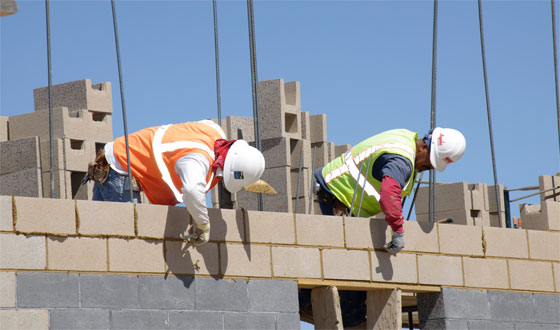Masonry is Key to Construction
Masonry is the building of structures from individual units laid in and bound together by mortar, and the term 'masonry' can also refer to the units themselves. The common materials of building material construction are brick, stone such as marble, granite, travertine, limestone; concrete block, glass block, and tile.
Masonry is generally a highly durable form of construction. However, the materials used, the quality of the mortar and workmanship, and the pattern the units are assembled in can strongly affect the durability of the overall masonry construction.
Masonry units, such as brick, tile, stone, glass brick or concrete block generally conform to the requirements specified in the 2006 International Building Code (IBC) Section 2103.
Hot To Lay Masonry Block: Learn how to layout, mortar and place masonry blocks for structural walls such as retaining walls and freestanding walls. This video was taken while we were making a retaining wall as part of a residential construction project. www.youtu.be
How to Use a Sod Cutter: Learn how to use a sod cutter and remove the sod before you trench your yard. this quick video will show you what a sod cutter does, and how easy is to use one. www.youtu.be
Making Grout Samples for Construction Inspection: The deputy inspector shows us how a masonry grout sample is made so it can be tested for compression. These tests are generally made when the grout strength will be above the normal standards. Always refer to your structural drawings to see if you need to have these types of testing done in your walls. For more tips, don't forget to check our videos about commercial and residential construction. www.youtu.be
Applications: Masonry is commonly used for the walls of buildings, retaining walls and monuments. Brick and concrete block are the most common types of masonry in use in industrialized nations and may be either weight bearing or a veneer. Concrete blocks, especially those with hollow cores, offer various possibilities in masonry construction. They generally provide great compressive strength, and are best suited to structures with light transverse loading when the cores remain unfilled. Filling some or all of the cores with concrete or concrete with steel reinforcement (typically "rebar") offers much greater tensile and lateral strength to structure.
How to Place Rebar: After you have excavated your footing, you need to layout the rebar or reinforcing steel in the footing. Our recommended steps:
- Layout the bars before you tie them together.
- Install the lower mat first. Then raise the steel mats 3" of the ground with dobies.
- Install the upper mats or vertical dowels.
- Install all your embeds such as j-bolts, rods and vertical dowels.
- Make sure that you follow the structural drawings for placement and overlap.
- All steel must be at least 3" away from the soil. Make sure they are not touching.
- Do not use dobies or shims made out of wood. Use concrete or masonry dobies, or even bricks will work.
- Don't forget to keep checking our site!
www.youtube.com
Our deputy inspector shows us how a masonry grout sample is made so it can be tested for compression. These tests are generally made when the grout strength will be above the normal standards. Always refer to your structural drawings to see if you need to have these types of testing done in your walls.
For more tips, do not forget to check our videos about commercial and residential construction. www.youtube.com
How to Lay Masonry Block: Learn how to layout, mortar and place masonry blocks for structural walls such as retaining walls and free standing walls. This video was taken while we were making a retaining wall as part of a residential construction project. www.youtu.com
Learn how to splice rebar or reinforcing steel by following the formula shown on your drawings. this call outs or details will typically show on your general notes, or in some cases they will be shown on a separate schedule on your sheets. this formula will be shown as following:
rebar splice shall be X bar diameter * Y
for example
# 5 rebar * 40 will be
(5/8) * 40 = 30"
Don't forget to add at least 4 wire ties in the rebar, we typically place 5 ties for each splice; however, in some cases your structural drawings will also request a specific number of ties on the splice. www.youtube.com
Disadvantages: Extreme weather may cause degradation of masonry wall surfaces due to frost damage. This type of damage is common with certain types of brick, though relatively rare with concrete block. If non-concrete (clay-based) brick is to be used, care should be taken to select bricks suitable for the climate in question. Masonry tends to be heavy and must be built upon a strong foundation (usually reinforced concrete) to avoid potential settling and cracking. If expansive soils (such as adobe clay) are present, this foundation may need to be quite elaborate and the services of a qualified structural engineer may be required, particularly in earthquake prone regions.
Structural limitations: Masonry boasts an impressive compressive strength (vertical loads) but is much lower in tensile strength (twisting or stretching) unless reinforced. The tensile strength of masonry walls can be strengthened by thickening the wall, or by building masonry "piers" (vertical columns or ribs) at intervals. Where practical, steel reinforcement also can be introduced vertically and/or horizontally to greatly increase tensile strength, though this is most commonly done with poured walls.
Ref: www.learningconstruction.com/Masonry_Videos.html

|